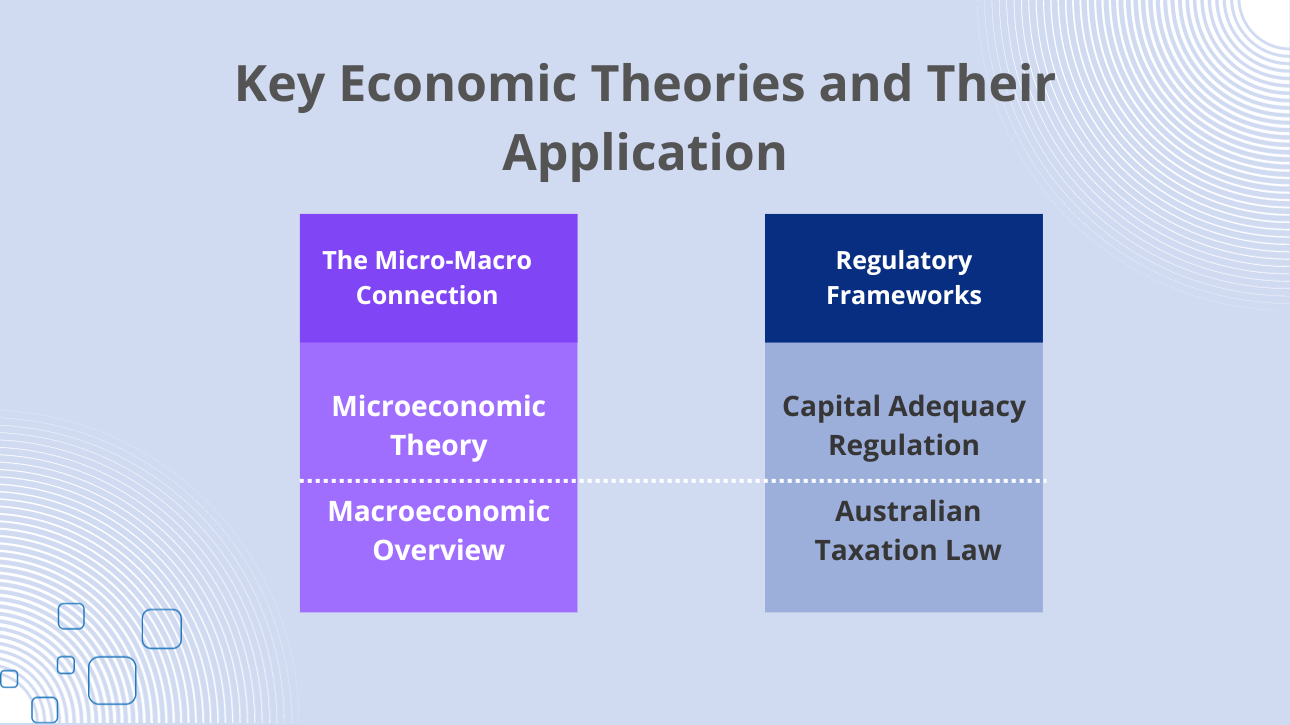Introduction
In Australia’s bustling financial service industry, the ability to apply economic principles is more than just a skill – it is a game-changer. It is not about jargon or complex theories. It is about understanding the heartbeat of our economy, from the intricacies of accounting information systems to the broader strokes of Australian taxation law.
Diving into this world, we see professionals striving to excel in various tasks. They harness the power of capital adequacy regulation, navigate through different work environments, and leverage the functions of digital tools. As we journey through this topic, we will uncover how these principles truly shape how we apply them to work in the dynamic sectors of our industry.
Understanding Economic Principles in the Financial Services Context
The Pillars of Financial Economics:
Financial Instruments Pricing: Setting the right price for things like bank accounts or loans is super important in the world of money and banking. It is like figuring out how much something is worth and making sure it is priced just right.
Risk Management Techniques: Every financial decision comes with its risks. Here, we delve into organisations’ and governments’ there are various measures and tactics that can be implemented to handle and reduce these risks.
Economic Theories in Action: Outside of schoolbooks, economic ideas really matter in the real world of money. They help decide how things work and affect the choices people make.
The Digital Revolution:
Functions of Digital Tools: In today’s world, where technology is everywhere, it is super important to know how digital tools work. These tools help us do things faster and more accurately, whether it is using special computer programs for accounting or everyday office gadgets.
The Role of Anthony Di Stasio: Anthony Di Stasio is a big name in digital finance. He’s all about bringing tech into the money world, showing how it can make things really different and better.
Table: Key Economic Principles and Their Relevance
| Economic Principle | Relevance to the Financial Services Industry |
| Understanding of Economics | Fundamental for informed decision-making. |
| Capital Adequacy Regulation | Ensures financial stability and trustworthiness. |
| Australian Taxation Law | Guides financial compliance and tax strategies. |
| Knowledge of Products | Enables tailored financial solutions for clients. |
Key Economic Theories and Their Application

The Micro-Macro Connection:
- Microeconomic Theory: This is about looking closely at different markets and seeing how they work. In the world of money and banking, it is like understanding how many people want something, how much of it is available, and how these things affect its price.
- Macroeconomic Overview: Taking a step back, imagine looking at the whole picture of our country’s money matters. This includes things like the total money everyone earns, the number of jobs available, and how fast our economy is growing. All these big ideas can cause changes and waves in the world of finance.
Regulatory Frameworks:
- Capital Adequacy Regulation: A cornerstone in the financial world, ensuring institutions maintain a certain level of capital to safeguard against potential losses. It is a buffer, a safety net, providing stability in turbulent times.
- Australian Taxation Law: A guiding light for financial professionals, ensuring all operations and transactions align with the nation’s tax regulations.
Table: Economic Theories and Their Practical Implications
| Economic Theory | Implication in the Financial Services Industry |
| Microeconomic Theory of Markets | Influences product pricing and market strategies. |
| Capital Adequacy Regulation | Ensures financial institutions’ stability and trust. |
| Understanding of Economics | Drives informed financial decision-making. |
Practical Application of Economic Principles

Financial Modelling and Decision-Making:
- Data-Driven Insights: Utilising financial modelling techniques on economic data provides a roadmap for decision-making, allowing professionals to forecast trends and make informed choices.
- Asset Pricing Models: These models are pivotal in determining the value of financial assets, ensuring that pricing aligns with market dynamics and intrinsic value.
Organisational Value and Capital Structure:
- Determining Value: By applying models that assess organisational value in relation to capital structure, businesses can gauge their financial health and make strategic adjustments.
- Capital Structure Dynamics: Understanding how debt, equity, and other financial instruments affect an organisation’s financial strategy.
Table: Tools and Techniques for Practical Application
| Economic Tool/Technique | Role in the Financial Services Industry |
| Financial Modelling Techniques | Forecasting, budgeting, and strategic planning. |
| Asset Pricing Models | Valuation of financial products and services. |
| Capital Structure Analysis | Evaluating financial stability and growth potential. |
Continuous Learning and Adaptation

The Ever-Evolving Landscape:
- Economic Shifts: The world of economics is dynamic, with new theories and principles emerging regularly. Staying updated ensures that professionals remain relevant and practical.
- Technological Advancements: With the rise of the functions of digital tools and accounting information systems, there is a need to adapt and integrate these into daily operations continuously.
Improving Performance Through Understanding:
- Deep Dive into Economics: A profound understanding of economics not only aids in decision-making but also enhances the quality of financial services offered.
- Feedback Loops: Regularly evaluating one’s work in the context of economic principles can highlight areas of improvement, driving excellence.
Table: Pathways for Continuous Learning
| Learning Avenue | Benefit to the Financial Services Professional |
| Economic Workshops & Seminars | Up-to-date knowledge and networking opportunities. |
| Digital Tool Training | Mastery of modern financial tools and software. |
| Feedback and Peer Reviews | Insights into areas of improvement and best practices. |
The Australian Perspective
Integration of Economic Principles:
- National Framework: Australia’s financial landscape is deeply influenced by its unique economic principles. These principles guide the industry’s operations, from capital adequacy regulation to Australian taxation law.
- RTOs and Their Role: Registered Training Organizations (RTOs) play a pivotal role in ensuring professionals are equipped with the knowledge to apply economic principles effectively.
Diving into Units of Competency:
- FNSINC601A & FNSINC601: These units emphasise the importance of applying economic principles in the financial services sector. They provide a structured approach, covering a range of tasks and functions essential for professionals.
Table: Key Aspects of the Australian Financial Services Industry
| Aspect | Description |
| Economic Regulatory Bodies | Organizations that oversee and regulate the industry’s operations. |
| RTOs and Training Units | Institutions and courses that equip professionals with industry-specific knowledge. |
| Industry Challenges & Opportunities | Current trends, challenges, and growth areas in the Australian financial landscape. |
Conclusion
Recap of Economic Principles in Finance:
- The Power of Application: It is not just about knowing the principles but effectively applying them. From understanding accounting information systems to navigating Australian taxation law, these principles are the backbone of the industry.
- The Australian Edge: With unique regulatory frameworks and a robust training system, Australia offers a distinct approach to integrating economic theories in the financial sector.
The Road Ahead:
- Continuous Evolution: The financial service industry is ever-evolving, and so is the world of economics. Staying updated and adaptable is the key to future success.
- Harnessing Digital Advancements: Embracing the functions of digital tools and modern technologies will be pivotal in shaping the industry’s future.
Call to Action:
VET Resources offers a wealth of knowledge and training materials for those keen on diving deeper and staying ahead in the industry. Stay informed, stay updated, and let us shape the future of finance together.
Frequently Asked Questions (FAQs)
Q1. What does apply economic principles mean in the financial world?
- Applying economic principles means using economic theories and ideas to make informed decisions in the financial sector, ensuring businesses grow and thrive.
Q2. How can I apply to work in the financial services industry?
- To apply to work in this industry, you typically need relevant qualifications and a good understanding of financial services functions. Then, you can apply for positions in various sectors of the industry.
Q3. What are the main financial services functions?
- Financial services functions include tasks like managing investments, providing loans, and offering insurance services, all of which require the application of economic principles.
Q4. Are there different sectors of the industry I should know?
- Yes, the financial services industry has various sectors like banking, insurance, investment, and more. Each sector has its unique functions and requirements.
Q5. What common office equipment is typically used in the financial services industry?
- Standard office equipment includes computers, calculators, printers, and specialized financial software tools that help professionals perform their tasks efficiently.
Q6. What are AQTF assessor requirements?
- AQTF assessor requirements are guidelines set by the Australian Quality Training Framework to ensure that those assessing vocational education and training are competent and qualified.
Q7. Where can I find reliable information on economic principles?
- A variety of sources can provide this information, including academic journals, financial news outlets, and official publications. Always check the time of publication to ensure the information is current.
Q8. How is the method of assessment determined in financial training courses?
- The method of assessment is chosen based on the course’s objectives. It can include written tests, practical evaluations, or project submissions. An overview of the assessment is usually provided at the start of the course.
Q9. Why is the assessment of performance crucial in financial roles?
- Assessing performance ensures that professionals are meeting industry standards and effectively applying economic principles. It helps identify areas of improvement and provides quality service.
Q10. Are there different ranges of assessment methods used in financial training?
- Yes, depending on the course and its objectives, various methods are available for assessing something, from written exams to hands-on practical evaluations. The goal is to ensure a comprehensive understanding of how to apply economic principles to work in the financial services industry.
Disclaimer:
The information presented on the VET Resources blog is for general guidance only. While we strive for accuracy, we cannot guarantee the completeness or timeliness of the information. VET Resources is not responsible for any errors or omissions, or for the results obtained from the use of this information. Always consult a professional for advice tailored to your circumstances.






